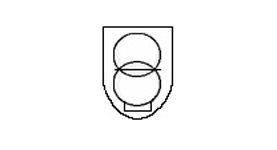- Joined
- 27 Jan 2008
- Messages
- 23,624
- Reaction score
- 2,661
- Location
- Llanfair Caereinion, Nr Welshpool
- Country

I seem to remember an isolating transformer with short circuit proof winding should show this sign

The little square on bottom shows short circuit proof. The shield means safety type. There are other variations, however looking at two USB adaptors on my desk, neither seems to show the safety markings, both show the Chinese Export (CE) sign.
With a grounded foil between the primary and secondary it is reasonably safe, or of course two bobbins on a grounded iron core, but that does increase losses, and the whole idea of 12 volt quartz lighting was increased lumen per watt. With LED today the capacitor is used to drop voltage and current which also can fail.
So in real terms lamps with exposed wires or rails need an isolated 12 volt supply, but unless exposed conductors are used why bother?
I read the heading and thought answer was to get enough length of tungsten, and actually it is a coiled coil. I never expected it to be about a transformer. As to isolation in the early days of computers the power supply would have a spare label which was to be placed on the computer case, to show anyone PAT testing that the power supply was an isolation type without the need to dismantle the computer. The power supplies often failed, and it was rare for anyone to attach the new label, I remember debating if we should accept the label on the outside or not? Don't think anyone worries today, but it was early days of PAT testing and although the computer may have been class I the items plugged into the computer were often not earthed and not Class II, so you could have metal connected to power supply vie one of the many plugs and sockets on the computer.

The little square on bottom shows short circuit proof. The shield means safety type. There are other variations, however looking at two USB adaptors on my desk, neither seems to show the safety markings, both show the Chinese Export (CE) sign.
With a grounded foil between the primary and secondary it is reasonably safe, or of course two bobbins on a grounded iron core, but that does increase losses, and the whole idea of 12 volt quartz lighting was increased lumen per watt. With LED today the capacitor is used to drop voltage and current which also can fail.
So in real terms lamps with exposed wires or rails need an isolated 12 volt supply, but unless exposed conductors are used why bother?
I read the heading and thought answer was to get enough length of tungsten, and actually it is a coiled coil. I never expected it to be about a transformer. As to isolation in the early days of computers the power supply would have a spare label which was to be placed on the computer case, to show anyone PAT testing that the power supply was an isolation type without the need to dismantle the computer. The power supplies often failed, and it was rare for anyone to attach the new label, I remember debating if we should accept the label on the outside or not? Don't think anyone worries today, but it was early days of PAT testing and although the computer may have been class I the items plugged into the computer were often not earthed and not Class II, so you could have metal connected to power supply vie one of the many plugs and sockets on the computer.

